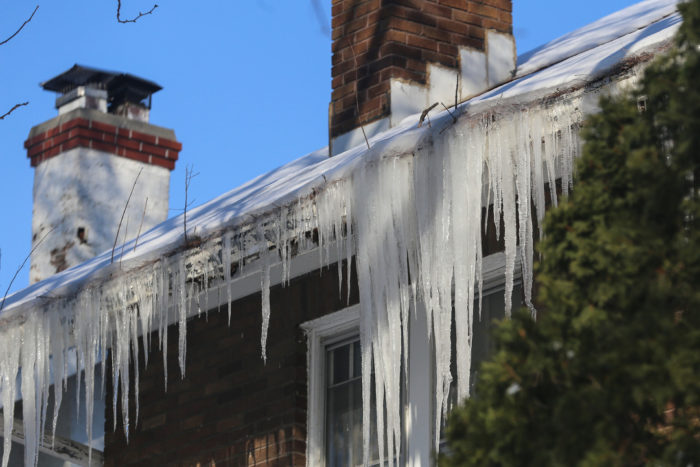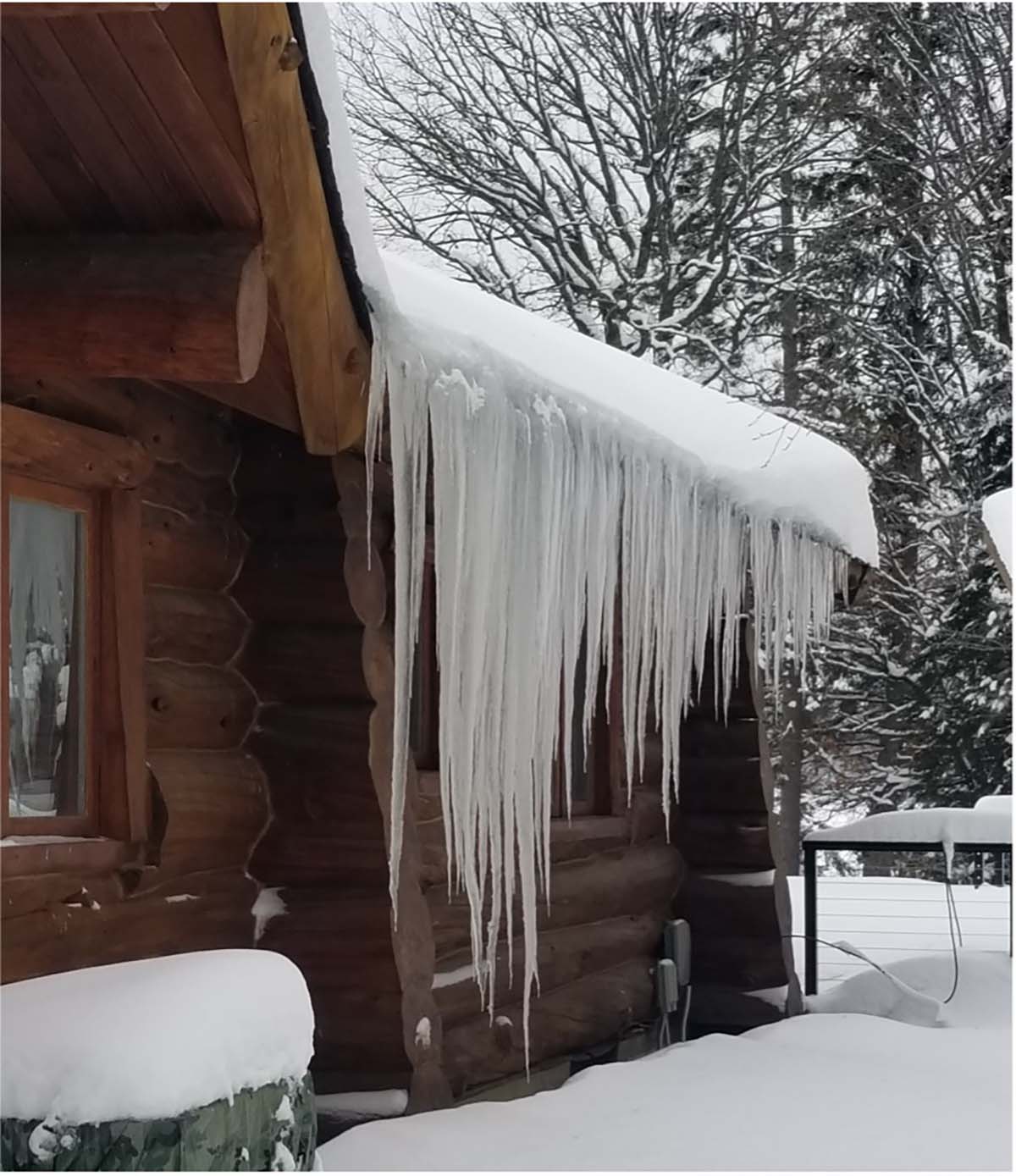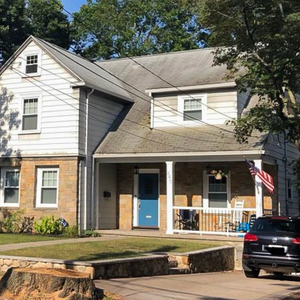
Image Credit: State Farm / Flickr
This past winter, national insurance companies were sending their “catastrophe response teams” to the Boston area. I personally met with adjusters and cleanup crews from places as far ranging as Minnesota, Utah, Tennessee, and Alabama.
The catastrophe had nothing to do with hurricanes or earthquakes or wildfires, of course — it had to do with the simple physics of heat loss from homes melting snow on roofs, and the unavoidable reality that the resulting water ended up in living spaces. Very little is more troubling to a homeowner than water where it doesn’t belong.
Why were the homes in our area so singularly unprepared for the snow we got this past winter? What happened? Two layers of issues: one technical and one socioeconomic.
The first problem is heat loss
The technical problem is pretty straightforward: unwanted and unnecessary heat loss (truth be told, there are a couple of additional technical factors; if you want to learn more about these check out this article I wrote a couple of years ago in the wake of another snowy winter).
Of the three forms of heat transfer — conduction, convection, and radiation — the biggest culprit in the formation of ice dams is convection, or air-transported heat. Warm air rises from the heated spaces of our homes, comes into contact with the underside of the roof sheathing, and melts the snow on top of the roof sheathing into water. The water runs down to the eaves where it freezes solid, causing water to back up behind it. The backed-up water makes its way into the soffit area or attic, flows into the wall and ceiling cavities, and eventually accumulates to a point where it starts to drip (or pour) out through the wall or ceiling plaster.
Why is it so hard to stop that heat loss? Most attics have insulation, after all — no? It’s true that most attics do have insulation. But the insulation tends to be fluffy, fibrous insulation like fiberglass or cellulose; this fibrous insulation does very little to stop air-transported heat. If you have a hole in your attic floor (even a small one) at a pipe or a wire or a duct penetration, for instance, you can put almost as much fibrous insulation in that area as you want and you’ll still have air-transported heat loss through the hole. You need to air-seal the hole first, and then add the fibrous insulation. You also need to air-seal all the other holes in the attic floor.
If you seal 50% of the air leaks, you don’t reap 50% of the benefits — you’ll just increase the rate of heat loss through the remaining 50% of the holes. You need to achieve close to 100% effectiveness with your air-sealing efforts to start to reap any benefits, unfortunately.
Socioeconomic factors make a contribution
And there’s the rub. In the Boston area, we make it very difficult to seal the holes in our attic floors. This is where the socioeconomic factors trump the building science factors. The building science is straightforward and intuitive. The socioeconomics are multi-layered and personal.
The socioeconomic factors preventing good air sealing in the Boston area are these: 1) homes are older and more ornate, 2) real estate is expensive, 3) homeowners are well educated and have parents or grandparents who lived through the Depression and World War II, and 4) people are getting more and more reliant on air conditioning.
Homes are older and more ornate. We like this. We’re used to it — to the point where we like our new homes to look like old homes, too. We’re architecturally very conservative in this region. Just look at all the traditional forms and vocabulary used in new residential construction. Older-style architecture tends to have complex roof forms. Lots of dormers and angles and cross gables and sometimes even turrets. Every architectural element added to a roof creates an opportunity for leaks, especially with four feet of snow sitting on the roof.

Real estate is expensive. Every square foot of a house in the Boston area has significant financial value. Every square foot of house that’s underutilized is wasting money. So we fill our houses up, preferably with living space. As a result, there are lots of finished basements and attics in the area (in fact, much of our own work consists of finishing off basements and attics). Many, many homes have finished attics, but very few have benefitted from proper air-sealing as part of the attic conversion. It’s very depressing to say to a homeowner that, in order to address the root cause of their ice dams, we’ll have to tear out most of the plaster in their third-floor master suite. Especially if that master suite was just completed in the last few years.
Homeowners are well educated and have parents or grandparents who lived through the Depression and World War II. This is a polite way of saying there’s a lot of stuff stored in attics throughout the area. We hang on to way too much. College papers (even high school papers, in some cases); boxes and boxes of books; clothing; vinyl LPs; baby stuff (just waiting for grandkids…); wedding presents from a few decades before, memorabilia from past generations. It’s not unusual for the cost of an air-sealing job to be less than the cost of the moving and storage required to be able to do the air sealing. I would love to develop a portable machine that can be used to grind up the contents of attics into high-quality insulation. That way, people could still keep their stuff in the attic, but it would be put to better use.
People are getting more and more reliant on air conditioning. Summers seem to be warmer, and two-career households have a harder time spending a lot of vacation time away in cooler places than traditional households of prior decades. So more and more Boston-area households are having central air conditioning systems installed. This would be fine, except that many air conditioning contractors don’t seem to care or have a clue about insulation and air sealing. I say this because of the number of AC system installations I’ve seen that have pretty much made it impossible to do a good job of insulation and air-sealing without first removing the recently-installed air conditioning system. This often adds enough to the cost of an insulation and air-sealing job that it just doesn’t happen.
Hoping for a break
With any luck, the anomalous winter of 2015 will not repeat itself and we will not again have to depend on any help from the fine citizens of Minnesota, Utah, Tennessee, and Alabama — or any other state, for that matter. But also, hopefully, the winter of 2015 will serve as a little bit of a wake-up call, and over time we’ll start to understand and overcome some of these factors that make it hard and unnecessarily expensive to improve the wintertime resilience of our homes here in eastern Massachusetts.
Paul Eldrenkamp is the founder of Byggmeister (Scandinavian for “Master Builder”), a remodeling company in Massachusetts. This post originally appeared at the company’s website.
Weekly Newsletter
Get building science and energy efficiency advice, plus special offers, in your inbox.















6 Comments
Your invention should be marketed
Paul,
I've heard you talk about this invention before, but I always smile when I think about it: "I would love to develop a portable machine that can be used to grind up the contents of attics into high-quality insulation."
You need a good name -- the Grind-and-Blow, perhaps. We all know that the raw material is there and waiting.
A digitizing version?
I suggest that the front end of this machine should be a document scanner. That way the old papers could be scanned before they are ground into insulation. I volunteer to test a prototype as I have both the stacks of paper and the underinsulated attic ready to go.
I nominate
Brain dump.
I'd like to dispute the
I'd like to dispute the statement: "If you seal 50% of the air leaks, you don’t reap 50% of the benefits — you’ll just increase the rate of heat loss through the remaining 50% of the holes. You need to achieve close to 100% effectiveness with your air-sealing efforts to start to reap any benefits, unfortunately."
The leakage through any opening depends on pressure drop across that opening. Pressure drop in winter will be mostly due to stack effect and wind pressure. Pressure drop across a small opening isn't linear with pressure difference, but closer to the square of flow, so that flow would go more like the square root of pressure drop. To seal 50% of the leaks and have the leakage through the remaining 50% of the openings increase anywhere near double would require a huge increase in the stack effect pressure drop. Unless the house is extremely leaky, that is unlikely. I would expect elimination of half the holes to reduce total leakage substantially. However, the leakage through the remaining 50% of the holes still could be huge by itself, so that plugging only half the leaks in a really leaky (old) home just isn't "good enough." Your thoughts?
Response to Dick Russell
Dick,
Thanks for your comments. You're right.
leakage vs. area
Whether Dick's approximation or Paul's approximation is more accurate depends on the other leaks in the envelope--any airflow has to come in one leak (usually in and around the basement), before it goes out another (usually the attic).
If the basement is very leaky, more leaky than the attic, the most of the stack effect pressure difference is across the attempted air barrier at the attic. That pressure difference is driven by temperature as Dick describes, and doesn't change as you seal some of the leaks. So if you seal 50% of the leaks, you drop the air flow by 50%.
If the basement is pretty tight, and has just a few small leaks, most of the stack effect pressure difference is between the outdoors and indoors at ground level, and there's very little pressure difference across the attic air barrier. In that case, Paul's approximation is correct--the airflow is determined by the size of the basement leaks, and sealing 50% of the attic leaks only diverts the same airflow through a smaller leakage area.
In that second scenario, if you seal enough of the attic leaks, you eventually get to the point where the attic leakage area is the limiting factor--when you are down to two 1/4" holes in the attic air barrier, when you seal one of the two, you cut half the airflow.
It's usually true that the most important leaks are in the basement and the attic, but of course if you get one of those sealed up well enough, air leakage at other levels becomes important, and it gets more complicated, but even without getting into that we can see that the there's a wide spectrum of possibilities for how much benefit you you get from sealing a given amount of leakage area.
Log in or create an account to post a comment.
Sign up Log in